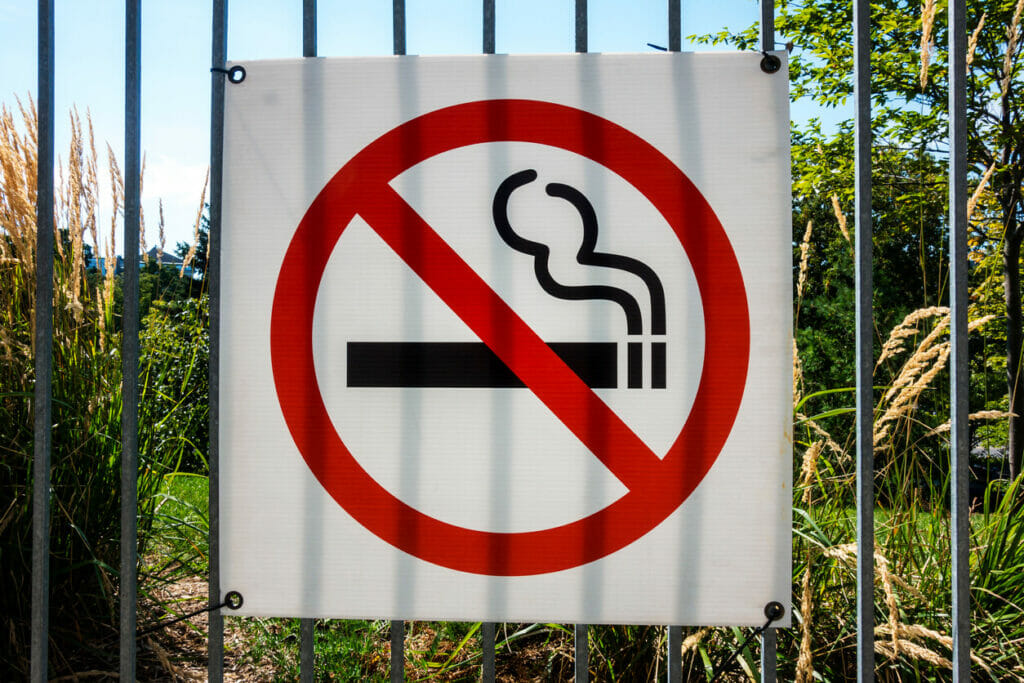A stringent new Mexican law is making it harder for anyone to smoke in public. Public spaces include parks, beaches, hotels, offices and restaurants. Several Latin American countries have passed legislation to create smoke-free public spaces, however, Mexico’s legislation is considered to be the most robust and wide-ranging in the Americas.
In essence, the new law limits smoking to homes and private residences. But this led us to wonder if individual residential communities might follow suit.
Table of contents
- State smoking bans
- HOA rules around smoking
- Amending and grandfathering rules
- What happens if someone breaks a smoking rule
State smoking bans
As of 2022, at least 28 U.S. states had enacted smoking ban policies in bars, restaurants, and worksites. However, many of those states exclude or do not cover casinos, private clubs, or certain small workplaces. Conversely, in Oklahoma and Virginia, state laws prohibit local governments from regulating smoking more strictly than the state, making those states among the few in the nation without any legislated smoking bans.
HOA smoking rules
State laws may impact how HOAs create smoking rules for shared spaces such as pools, barbeque areas and other indoor amenities. Smoking has been and continues to be a contentious issue in community associations. And it’s not just cigarette smoke – boards have to think about rules regarding vaping and marijuana as well.
Smoke can be a huge problem for condominium communities since the smell and effects can easily travel to neighboring units, but it can be less problematic in single-family communities since members don’t share a wall.
Nevertheless, one of the most common complaints that HOA boards receive is regarding second-hand smoke from a neighbor. This is also one of the most difficult issues to navigate because there are strong feelings on both sides.
Unless there are state laws that regulate where people can and cannot smoke, there is no legal requirement for an association to adopt smoking restrictions. However, HOAs may find legal support if they are serious about implementing a smoking ban, or limitations, in common areas, restricted common areas, and even within units.
Due to the indisputable harmful effects of second-hand smoke, almost all associations have a nuisance clause associated with smoking in their governing documents. The limitations generally prevent people from smoking (and vaping) in shared common areas, such as clubhouses, pool areas, stairwells, etc. The limitations are often more extensive for condominium associations, and owners may not have the option to smoke on their balconies depending on the community and any smoking issues that have impacted owners in the past.
Common areas
As a rule of thumb, where an association’s governing documents state that the association owns, controls, and maintains the development’s common area, the board likely can prohibit smoking in these spaces. Common areas may include outdoor areas like parking structures, swimming pools and recreational areas, as well as interior hallways of condominium buildings.
Associations have an obligation to ensure common areas are reasonably safe and maintained, which means boards must take steps to minimize safety hazards. While the term is a bit ambiguous, a safety hazard may include something like second-hand smoke.
A judge in California ruled second-hand smoke to be a safety hazard when a resident of an apartment appealed a previous court decision. The judge noted that the landowner, in this case, an apartment complex, owed a duty to the resident to keep the premises reasonably safe, and the landowner’s failure to adopt a no-smoking policy for outdoor common areas constituted a breach of that duty.

Complete bans
Though much rarer, a handful of associations have moved forward with a complete smoking ban. That is to say, the association is 100% smoke-free. While the majority of communities would have the ability to create a smoke-free environment, it is much harder to gain support for that from members and enforce such a ban.
If there are several people who feel very strongly about limiting the impacts of second-hand smoke, the condo or HOA is encouraged to explore how ventilation systems, weather-stripping of doors and windows, and related building components may be improved to limit the spread of smoke before proposing a complete ban.
Requiring smokeless ashtrays, the installation of an air filtration system or other measures to diffuse smoke may also offer workable solutions.
Amending and grandfathering rules
If it becomes necessary to change or modify smoking rules, the HOA will first need to understand if the amendment requires a member vote. A proposal for a smoke-free community would almost certainly require support from the majority of members, but an existing policy update could probably be made without seeking a vote from all owners.
An HOA can either adopt a rule or amend the existing CC&Rs. Rules are much easier to change, but CC&R amendments signify a sterner approach to smoking restrictions.
Even if the association successfully changes the CC&Rs or rules, it should be prepared to accommodate owners who smoke, depending on the severity of the rule. A grandfather clause is a provision in which an old rule continues to apply to existing situations (or people). In this case, if a complete ban were enforced, current owners who smoke would likely still be permitted to light up in their homes. However, once they moved out of the association, the new owners would not be granted this freedom. Less restrictive rules, such as limits on smoking in shared areas, would likely apply to everyone though.
Grandfathering is an effective way of balancing the wants and needs of different parties, while allowing the association to enforce a particular rule on the entire community over time.
What happens if someone breaks a smoking rule
Smoking rules will not be effective if the board doesn’t treat smoking issues the same way it treats other violations. Associations must handle this problem as they would any other rule violation.
Condos and HOAs have unique processes for enforcing rules. Often, but not always, they will start with a warning letter, then issue a formal letter, and move on to fines or other corrective steps if the problem persists.
Using software to implement a formal violation system ensures consistency, and that’s a good thing. Sending notices electronically as opposed to through the mail also speeds up resolution timelines, and it is harder for owners to claim that they never received the violation notice.
Regardless of the system the association uses, it must be applied fairly and consistently in order for smoking rules to be taken seriously.
Conclusion
In theory, it is possible for a condo or HOA community to completely prohibit smoking. However, most associations will find it easier and more practical to implement restrictions as opposed to complete bans. Although smoking does pose health risks to smokers and the people who are exposed to second-hand smoke, owners should also be able to reasonably enjoy their homes. That generally means finding a middle ground for people who choose to smoke.
Owners who live in condo communities and share a wall with their neighbors may need to be more considerate of others if they smoke. The association could ask them to use air filters or add high-quality weather stripping to windows and doors in order to help prevent the smoke from wafting into other units.
If the issue of smoking has worsened in your community, it may be time to consult with an HOA lawyer to help you figure out possible strategies and solutions.


